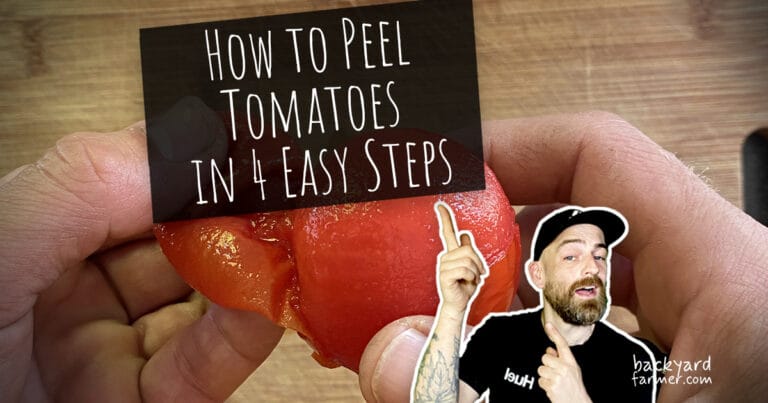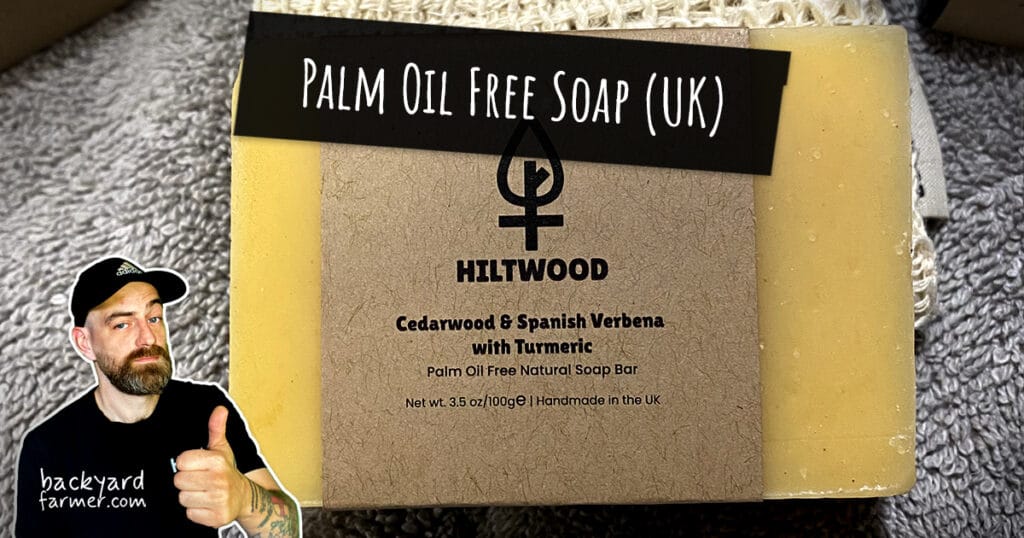Table of contents
- Introduction
- Why Peel Tomatoes for Sauces, Salsa, and Cooking?
- Method 1: Blanching – The Best Way to Peel and Skin Tomatoes
- Method 2: Peeling Tomatoes in the Microwave
- FAQ: How to Peel and Skin Tomatoes Easily
- Tips and Best Practices for Peeling Tomatoes Quickly
- Blanching vs. Microwaving – Best Way to Peel Tomatoes
- What to Do with Tomato Skins
- Final Thoughts: The Easiest Ways to Peel Tomatoes at Home
Introduction
Peeling or skinning tomatoes doesn’t have to be messy or time-consuming. Whether you’re wondering how to peel a tomato quickly or looking for the best way to skin tomatoes, there are simple methods anyone can use.
If you’re making a smooth tomato sauce, whipping up some salsa, or preparing any dish that calls for skinless tomatoes, knowing how to peel them efficiently can save both time and effort.
This guide will show you how to peel tomatoes in four simple steps using two foolproof methods:
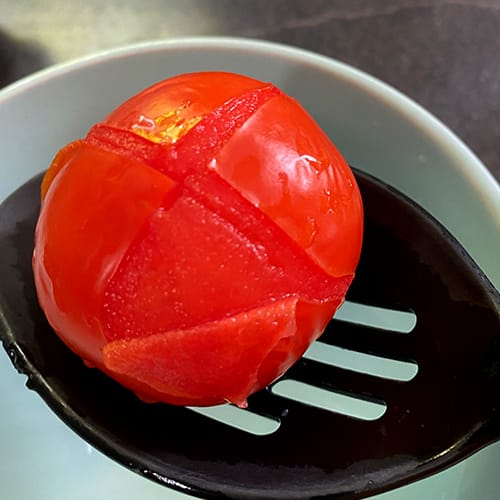
- Blanching
- Microwaving
Each method is fast, effective, and perfect for cooks of any skill level. Plus, these techniques minimize waste and mess, making them ideal for everyday kitchen use. If you’re batch cooking and need to freeze the tomatoes, check out our guide to ‘Freezing Tomatoes’ for some extra handy tips!
If you’re wondering how to peel tomatoes quickly, the two methods below will save you time, reduce mess, and give you perfect results every time — whether you’re cooking for one or prepping a big batch for storage.
Blanching: The Classic Method
Blanching has been trusted by chefs for generations. This straightforward process involves:
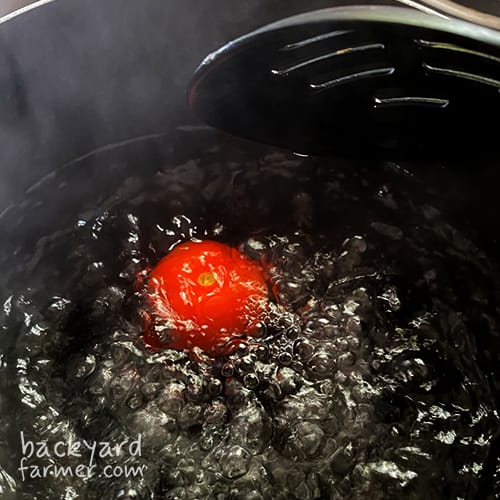
- Boiling the tomatoes briefly
- Cooling them in ice water to loosen the skins
Blanching is perfect when you need to peel large batches. It’s reliable and delivers smooth, consistent results every time.
Microwaving: The Simpler Alternative
If you’re looking for something quicker and less messy, microwaving is your go-to method. This approach:
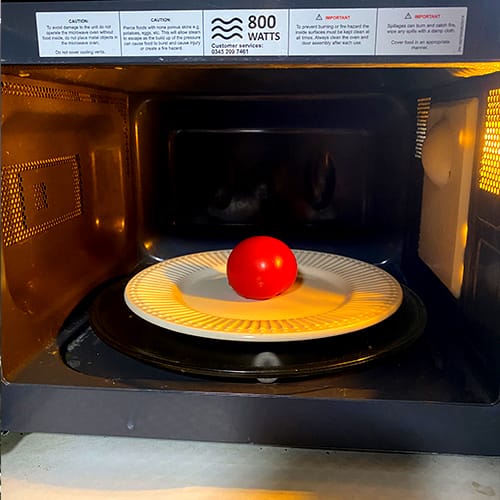
- Requires minimal equipment
- Delivers fast results with very little prep
Microwaving is ideal for small quantities and skips the hassle of boiling water, saving both time and energy.
No matter which method you choose, you’ll end up with perfectly peeled tomatoes ready to elevate your favorite recipes. Since each technique caters to different needs, it’s easy to pick the one that fits your routine.
Why Peel Tomatoes for Sauces, Salsa, and Cooking?
Tomato skins might seem harmless, but peeling them can make a big difference in your cooking. Here’s why taking this extra step is worth it:
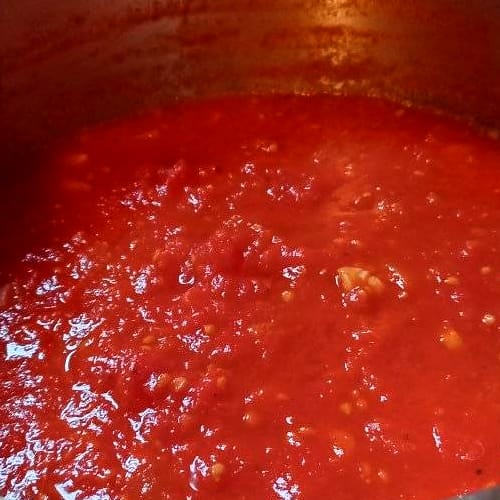
1. Enhance Flavor and Texture
- Skins often turn tough and unpleasant in smooth dishes like soups, sauces, and salsas.
- Removing the skin gives your dish a silky texture and lets the natural tomato flavors shine.
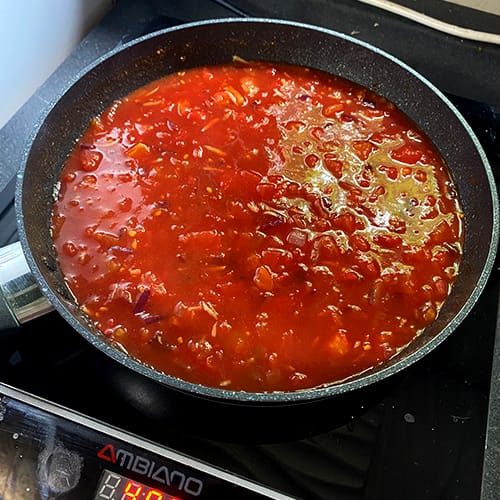
2. Better Integration in Recipes
- Peeled tomatoes blend seamlessly into dishes, so you’re not left with unwanted chunks of skin.
- They’re perfect for creating rich, velvety sauces or creamy bases that feel polished and professional.

3. Easier Digestion
- Tomato skins are high in fiber, which can be harder for some people to digest.
- Peeling makes dishes gentler on the stomach and more enjoyable to eat.
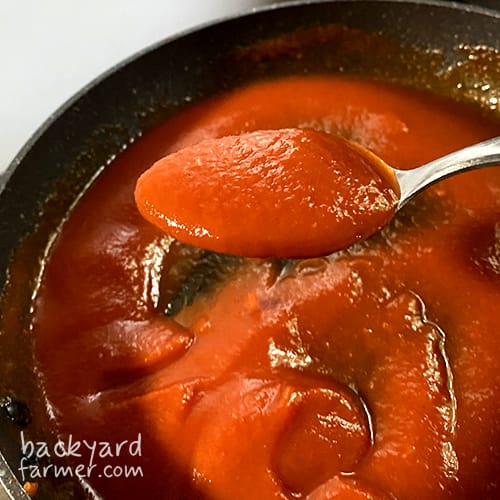
4. Improved Presentation
- Peeled tomatoes look polished and professional.
- This makes them ideal for recipes where appearance matters, like fresh salads, elegant garnishes, or chilled dishes such as gazpacho.

5. Perfect for Freezing and Canning
- Skins can toughen and alter texture during freezing or canning, but peeled tomatoes hold up beautifully.
- This step ensures your frozen or canned tomatoes maintain great quality when used later.
Peeling Tomatoes for Canning
When you peel tomatoes for canning, it helps preserve their texture and flavour over time. Blanching is the best way to prepare tomatoes for canning — it loosens the skin gently while keeping the flesh firm and full of flavour, ensuring your jars stay vibrant and smooth.
Whether you’re crafting a smooth marinara, preparing a refreshing gazpacho, or saving a summer harvest for the colder months, peeling your tomatoes adds that extra touch of care. It’s a small step that guarantees your dishes will look better, taste better, and feel more professional every time!
Learn more about the mighty tomato and its origins in South America here.
Now that you know why peeling tomatoes can make such a difference, let’s look at the easiest methods you can use at home. The first (and most traditional) way is blanching.
Method 1: Blanching – The Best Way to Peel and Skin Tomatoes
Blanching is one of the most popular and reliable ways to peel tomatoes. This simple technique uses boiling water and ice to loosen the skins, making them easy to remove without damaging the flesh. It’s also a great prep step if you plan to freeze or preserve your tomatoes.
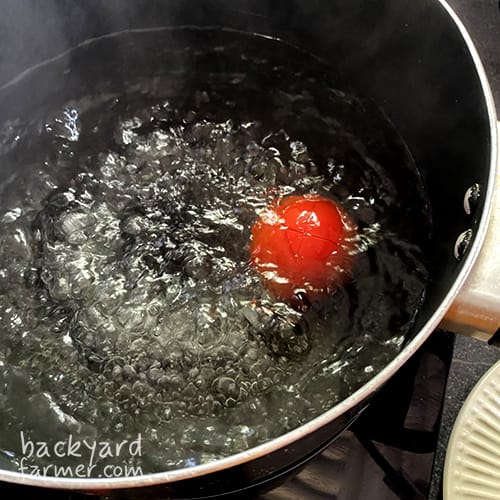
Skinning Tomatoes in Boiling Water (Classic Kitchen Tip)
Skinning tomatoes in boiling water is the traditional chef’s method — simple, fast, and perfect when you need to remove skins cleanly for sauces or canning. The boiling water loosens the peel just enough for it to slide off easily without cooking the tomato through. Follow these steps to master this classic method:
What You’ll Need
- A pot of boiling water (around 212°F / 100°C)
- A bowl of ice water
- A sharp knife
- A slotted spoon
How to Peel Tomatoes by Blanching (Best Method for Large Batches)

1: Score the tomato skin with a knife
- Use a sharp knife to cut a small “X” at the base of each tomato.
This simple step helps the skin peel off easily after blanching.

2: Boil tomatoes briefly in hot water
- Carefully drop the tomatoes into the pot of boiling water.
- Let them simmer for 30–60 seconds, or until the skin starts to wrinkle or pull away.

3: Cool tomatoes in ice water to loosen skin
- Use a slotted spoon to transfer the tomatoes from the boiling water to the bowl of ice water.
- Let them chill for a few minutes to cool completely and stop the cooking process.

4: Peel tomato skins off easily by hand
- Once the tomatoes are cool, gently remove them from the ice water.
- Starting at the scored cuts, use your fingers to peel off the skin — it should slide off effortlessly.

Tips for Success
- Pick ripe, room-temperature tomatoes for the best results.
- Avoid overcooking the tomatoes in boiling water, as this can make them too soft.
- Blanch in small batches to keep the water temperature consistent.
- Don’t toss the skins! Save them to make tomato powder, enhance stocks, or add to your compost.
Blanching is a time-tested technique that works for all kinds of tomatoes. Whether you’re prepping a large batch for canning or just a few for tonight’s dinner, this method guarantees smooth, professional-quality results every time. Once peeled, your tomatoes are ready to elevate any dish!
Method 2: Peeling Tomatoes in the Microwave
If you’re searching for how to peel tomatoes without blanching, microwaving is the quickest method. This approach is ideal when you need to peel tomatoes quickly with minimal mess. This method works well when you’re short on time or just don’t want to deal with extra pots and pans. Plus, it’s an eco-friendly option that uses less water and energy than blanching.

These methods show you exactly how to peel tomatoes easily — no special tools, no messy clean-up, and no waste. Just a few minutes of prep and your tomatoes are ready for any recipe.
Follow these steps to peel tomatoes in no time:
What You’ll Need
- A microwave-safe, non-metallic dish
- A sharp knife
- A bowl of ice water
How to Peel Tomatoes Without Blanching (Quick Microwave Method)

1: Score tomatoes before microwaving
- Use a sharp knife to cut a small “X” at the base of each tomato. This step helps the skin loosen easily when heated.
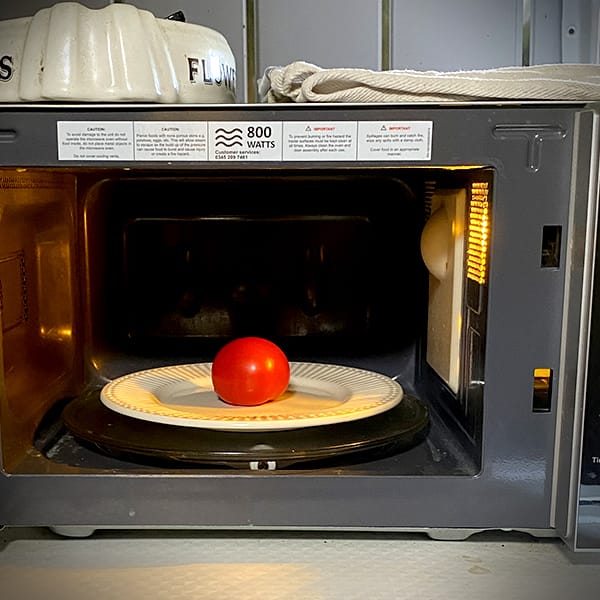
2: Heat tomatoes in the microwave
- Place the tomatoes in a microwave-safe dish.
- Microwave on high for 20–30 seconds, or until you notice the skin starting to wrinkle or loosen.
- Keep an eye on them to avoid overcooking, especially with smaller tomatoes.
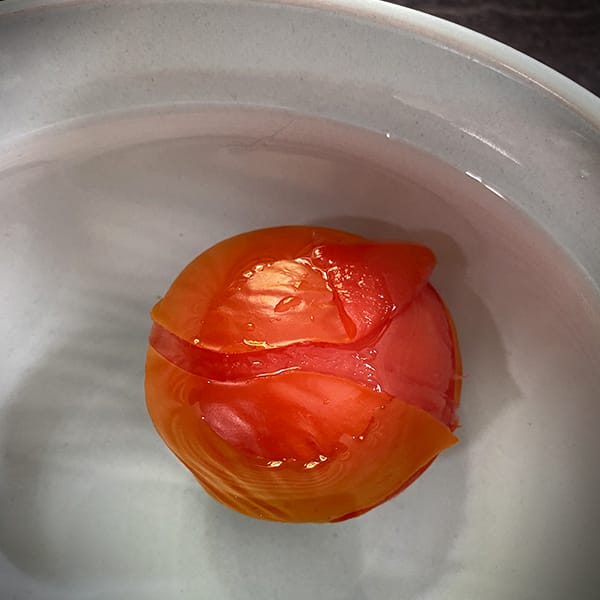
3: Cool tomatoes in ice water
- Carefully remove the tomatoes from the microwave and immediately transfer them to a bowl of ice water.
- Let them chill for a few minutes to cool down and stop the cooking process.
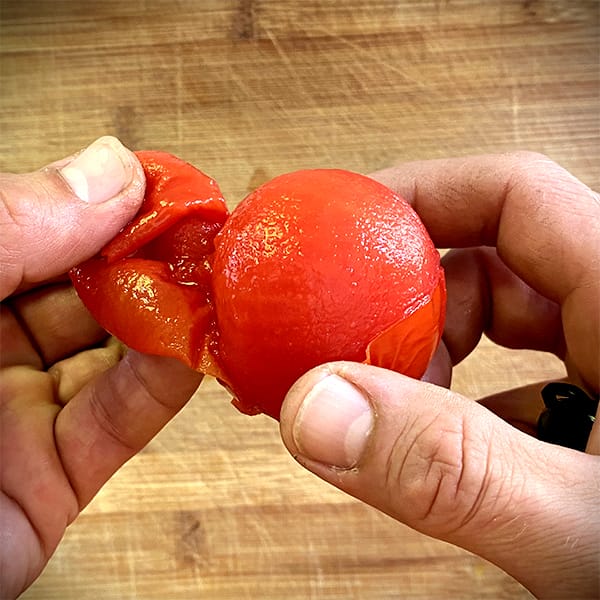
4: Peel skins from tomatoes easily
- Once the tomatoes are cool, take them out of the ice water.
Starting at the scored cuts, gently peel off the skin — it should come off effortlessly.
Pros and Cons of the Microwave Method
Pros:
- Quick and convenient
- No need for boiling water or extra tools
- Energy-efficient and eco-friendly
Cons:
- Tomatoes can become too soft if overheated
- Not ideal for large batches or tougher-skinned tomatoes
Tips for Success
- Choose ripe, firm tomatoes for the best results.
- Adjust the heating time based on the size of the tomatoes.
- Work in small batches to prevent overcooking and ensure consistent peeling.
Microwaving is an excellent choice when you need peeled tomatoes quickly, especially for recipes like salsa or bruschetta.
With this method, you’ll have perfectly peeled tomatoes ready to take your dishes to the next level with minimal effort!
Ever wondered how people grow tomatoes indoors? Well, we know how — check out our guide to ‘Growing Tomatoes Indoors’ here.
With both blanching and microwaving covered, you might still have a few common questions about peeling tomatoes. Here are some quick answers to the most frequently asked ones.
FAQ: How to Peel and Skin Tomatoes Easily
The best way to skin a tomato is by blanching. Drop the tomatoes into boiling water for 30–60 seconds, then transfer them to ice water. The skin will wrinkle and peel off easily, leaving you with smooth, firm tomatoes ready for sauces or freezing.
You can use a microwave to peel tomatoes quickly and easily. Score an “X” on the base, heat them for 20–30 seconds, and then transfer them to ice water. The skin will slip right off, making this method perfect for small batches.
Peeling tomatoes for sauce isn’t mandatory, but it’s highly recommended. Without the skin, your sauce will have a smoother texture and a richer flavor. Tomato skins can add bitterness and a chewy texture, which might not be ideal for delicate recipes like marinara.
The easiest way is blanching. Boil the tomatoes briefly, cool them in ice water, and peel the skin right off. This method is great for large batches and guarantees even, consistent results.
First, peel the tomatoes using either blanching or the microwave method. Then, cut them in half horizontally and scoop out the seeds using a spoon or your fingers. This simple trick is especially helpful for sauces and soups.
Yes, you can! A serrated potato peeler works well for firm, ripe tomatoes. However, this method might not be the best for softer or overripe tomatoes, as they can tear easily.
Blanch tomatoes for 30 to 60 seconds, just long enough for the skin to start loosening. If the skins are tougher, leave them a little longer, but avoid overcooking to keep the flesh firm.
Peeling is optional for salsa. If you want a smooth texture, peeling is the way to go. For chunkier salsas, leaving the skin on is perfectly fine and can add a bit of extra texture.
Blanch green tomatoes the same way as ripe ones. Their firmer skin may need a slightly longer boiling time, but the process works the same. Once the skin loosens, cool them in ice water and peel away.
Absolutely! You can freeze tomatoes whole with the peel on. When you’re ready to use them, thaw them, and the skin will slide off easily. This method is super convenient for preserving fresh tomatoes.
Learn how to freeze tomatoes properly with our guide ‘How to Freeze Tomatoes’ here.
Peeling is a personal choice, but it can improve the texture in dishes like salads or garnishes. If you prefer a smoother bite, go ahead and peel them. Otherwise, leave the skin on for extra fiber.
Yes, most canned tomatoes are peeled before processing. This includes whole and diced varieties, making them smooth and ready to use in recipes without extra prep.
Blanching is the best way to peel cherry tomatoes. Boil them for 15–20 seconds, cool them in ice water, and gently peel starting from the scored base. Handle them with care since cherry tomatoes are delicate and can burst easily.
Tips and Best Practices for Peeling Tomatoes Quickly
Learning how to peel or skin tomatoes doesn’t have to be overwhelming or messy. With these methods, you can prepare tomatoes quickly and easily for any recipe. Whether you’re getting them ready for a sauce, salsa, or another recipe, these tips will help you peel like a pro while saving time and reducing waste.

1. Use Ripe, Fresh Tomatoes
- Always choose ripe tomatoes because their skin loosens naturally when heated.
- Avoid overripe ones since they can get too soft during peeling.
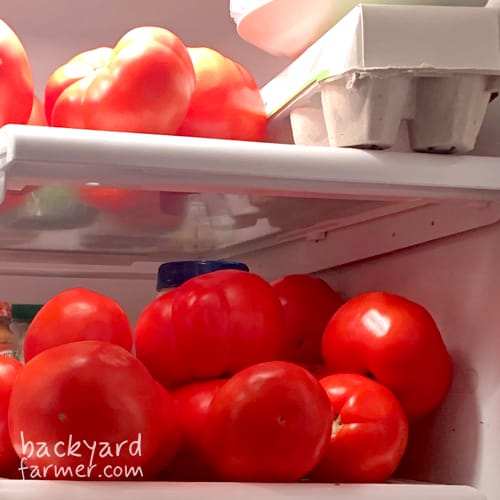
2. Work with Room-Temperature Tomatoes
- Room-temperature tomatoes peel much more easily than chilled ones.
- If they’ve been in the fridge, let them sit out for 20–30 minutes before starting.
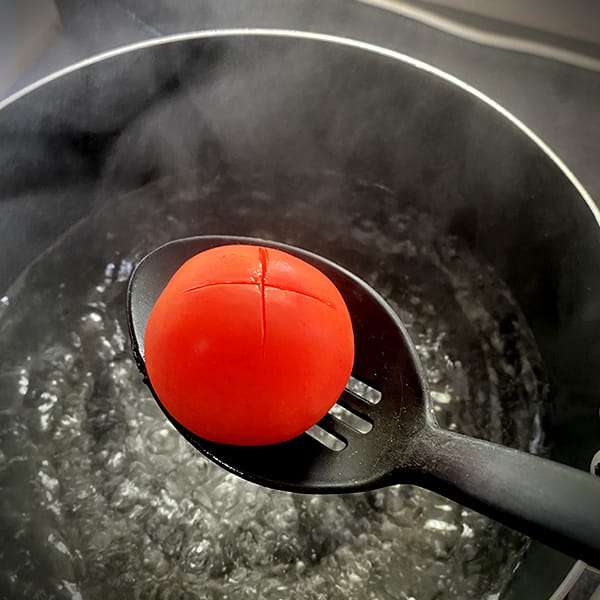
3. Score the Tomatoes
- Take a sharp knife and cut a small “X” at the base of each tomato.
- This step makes the skin much easier to remove. For smaller tomatoes like cherry tomatoes, use lighter cuts to avoid damaging the flesh.
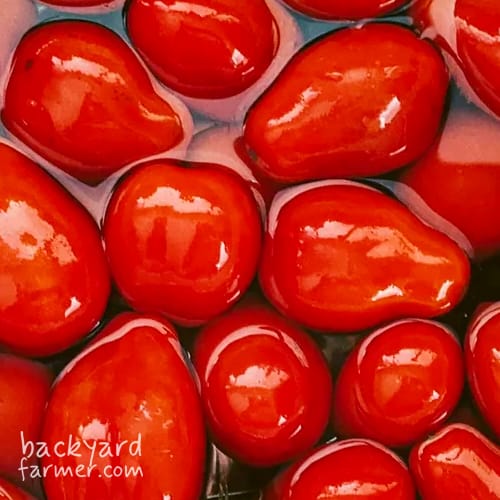
4. Blanch in Small Batches
- When blanching, avoid overcrowding the pot. Smaller batches help maintain the water temperature and make peeling easier.
- Adjust blanching times based on tomato size: 15–20 seconds for cherry tomatoes and 30–60 seconds for larger ones.
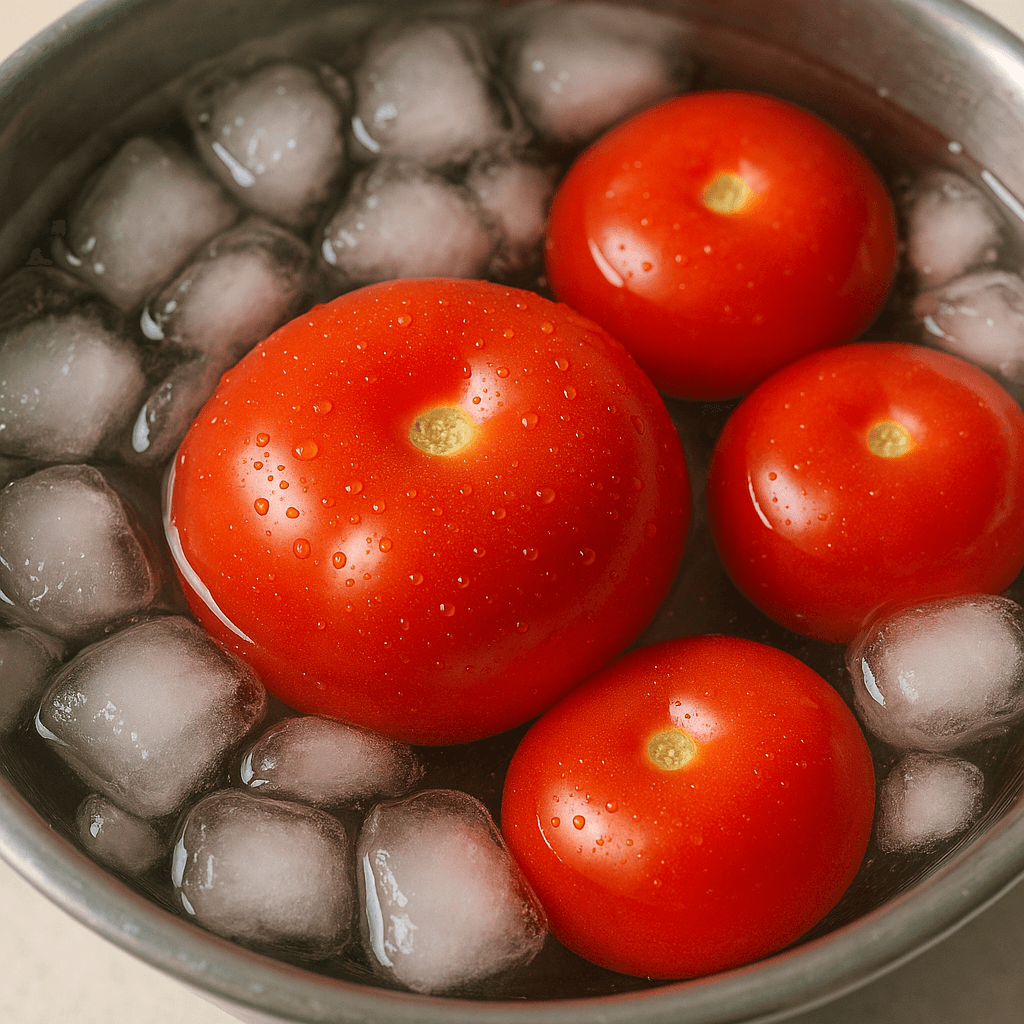
5. Use Ice Water for Cooling
- After blanching or microwaving, immediately transfer the tomatoes to a bowl of ice water. The sudden chill stops the cooking and helps loosen the skin even more.

6. Handle with Care
- Be gentle when peeling, especially with soft or very ripe tomatoes, to avoid crushing them. Use your fingers or a soft tool for peeling instead of anything abrasive.
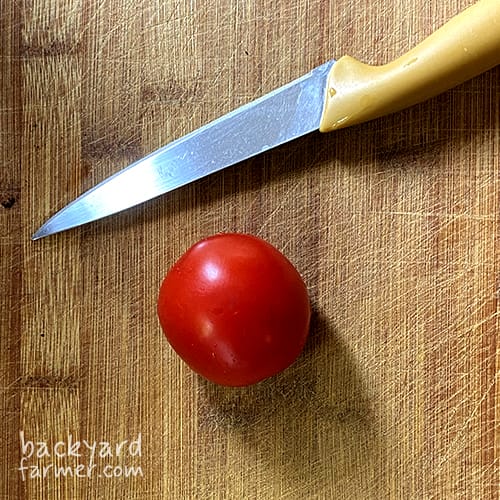
7. Prepare Your Tools Ahead of Time
- Have everything ready: a sharp knife, slotted spoon, pot, ice water bowl, and a peeling dish. Staying organized makes the whole process much smoother.
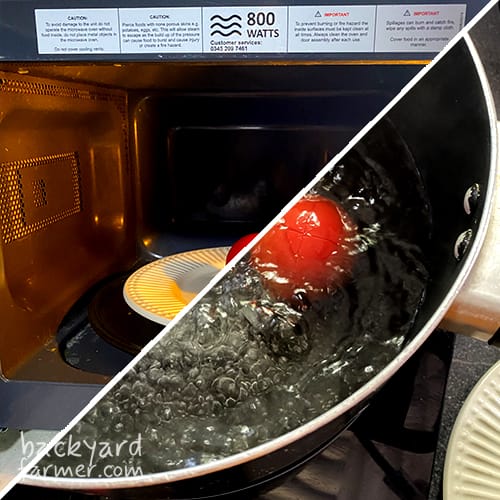
8. Experiment with Methods
- Blanching is the go-to method, but microwaving is great for small batches.
- Try both to find what works best for you. Microwaving can also be more eco-friendly, using less water and energy.
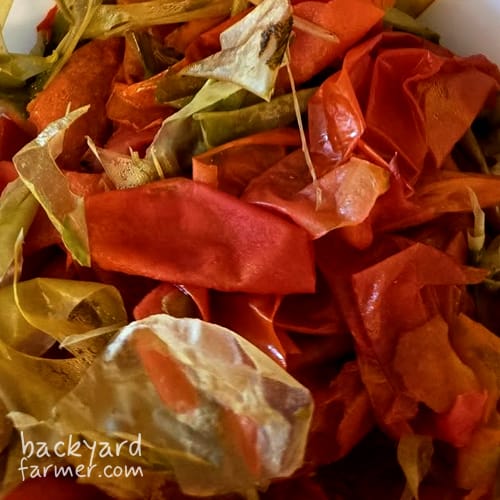
9. Save the Peels
- Don’t toss the peels—they’re packed with nutrients! Use them to make tomato powder, enhance stock, or add to your compost.
- For a zero-waste kitchen, dry the peels and grind them into seasoning.

10. Practice Makes Perfect
- The more you peel, the faster and more confident you’ll get. Don’t worry if it feels tricky at first—you’ll get the hang of it in no time.
By following these best practices, peeling tomatoes will feel like second nature. You’ll save time, reduce waste, and get perfectly prepped tomatoes every time. Happy peeling!
Blanching vs. Microwaving – Best Way to Peel Tomatoes
Deciding how to peel your tomatoes depends on what you need and how much time you have. Some methods are better for big jobs, while others work perfectly when you’re in a rush. Here’s a breakdown of the two most popular ways to help you choose what fits your kitchen best:
1. Blanching: The Classic Choice
Best For:
- Large batches of tomatoes. Recipes like marinara, sauces, or canned tomatoes that need smooth, uniform results.
Advantages:
- Works reliably for all kinds of tomatoes. Delivers even peeling with minimal waste. Perfect for freezing or preserving a fresh harvest.
Considerations:
- Takes a bit more preparation since you need boiling water and ice. Cleanup can take longer compared to other methods.
Ideal Scenario:
If you’re peeling a big batch for canning or cooking, blanching is your best bet. It’s efficient and leaves you with perfectly peeled tomatoes every time.
2. Microwaving: The Quick and Easy Option
Best For:
- Small batches of tomatoes.
- When you’re in a hurry or want to skip the hassle of boiling water.
Advantages:
- Super fast and incredibly convenient. Requires minimal equipment—just a microwave-safe dish.
- Eco-friendly since it uses less water and energy than blanching.
Considerations:
- There’s a risk of overcooking, which can make the tomatoes too soft to peel easily.
- Not ideal for large batches or tough-skinned varieties.
- Best for immediate use, like in salsa or bruschetta.
Ideal Scenario:
When you need to peel a few tomatoes quickly, the microwave method is a lifesaver. It’s perfect for weeknight dinners or whenever you want to keep things simple.
Comparison Table: Blanching vs. Microwaving
| Criteria | Blanching | Microwaving |
|---|---|---|
| Batch Size | Large | Small |
| Time Required | Moderate | Quick |
| Ease of Use | Simple but involves more steps | Very simple, fewer steps |
| Equipment Needed | Pot, boiling water, ice | Microwave-safe dish |
| Consistency | Very uniform | Can vary slightly |
| Eco-Friendliness | Requires more resources | Uses less water and energy |
Which Should You Choose?
- Choose blanching for big jobs where precise results are key, especially for canning or making smooth sauces.
- Opt for microwaving when you’re short on time and need a quick, hassle-free option for smaller batches.
Here’s your text with boldening for scannability (kept in one line as written):
No matter which method you choose, both will leave you with perfectly peeled tomatoes, ready to take your recipes to the next level. Happy peeling!
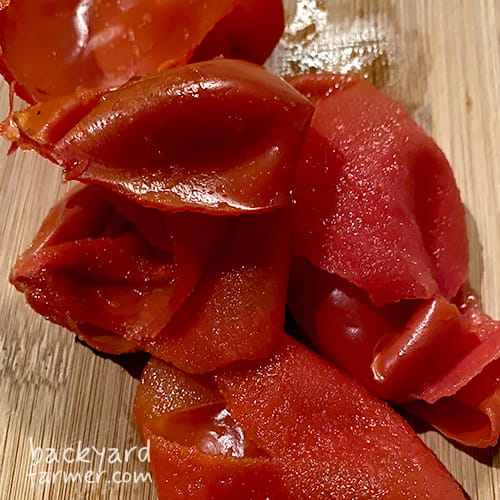
What to Do with Tomato Skins
Don’t bin those tomato skins—turn them into something brilliant instead! They might seem like waste, but they’re actually packed with flavour, nutrients, and loads of potential. Whether you’re trying to reduce kitchen waste or get the most from your tomatoes, here are some creative and sustainable ways to reuse tomato skins:
1. Make Tomato Powder
Dry the skins in a low oven or food dehydrator until they’re completely crisp. Then, blend them into a fine tomato skin powder using a spice grinder or blender. This homemade tomato powder adds a punchy, umami-rich flavour to pasta sauces, soups, and stews—or even works as a savoury seasoning on eggs or toast.
Pro Tip: Store your tomato powder in an airtight jar and keep it somewhere cool and dark—it’ll stay fresh for months!
2. Add to Stocks and Broths
Instead of tossing them, add tomato peels to homemade stock or broth. Whether you’re making vegetable, chicken, or beef stock, tomato skins bring extra richness and depth to the flavour—without needing salt or additives.
3. Turn into Crispy Tomato Skin Chips
Toss your tomato skins with a little olive oil and sea salt, then bake them until crispy. These tomato skin chips make a surprisingly delicious snack or a crunchy garnish for soups and salads.
4. Add to Your Compost Bin
Not in the mood to cook? No worries—tomato skins are excellent compost material. They’re nitrogen-rich and break down well in compost bins, making them perfect for boosting soil health naturally.
5. Freeze for Later
No time right now? Pop your tomato skins into a freezer-safe bag and store them until you’re ready to use them. They’ll be perfect for stocks, sauces, or drying into powder whenever it suits you.
By using these simple tomato skin ideas, you’ll reduce waste in the kitchen and make the most of every tomato!
Final Thoughts: The Easiest Ways to Peel Tomatoes at Home
Peeling tomatoes doesn’t have to be overwhelming or messy. By understanding the different methods and picking the one that suits your needs, you can prepare tomatoes quickly and easily while minimizing effort and waste.
Choose Your Method
- Blanching: Perfect for large batches, recipes that need smooth, uniform results, or preserving tomatoes for freezing or canning.
- Microwaving: Ideal if you’re short on time or working with a smaller batch. It’s quick, simple, and eco-friendly, using less water and energy.
Key Tips for Success
- Always choose ripe, room-temperature tomatoes for the easiest peeling.
- Keep your tools ready: a slotted spoon, sharp knife, and ice water bowl can make the process smoother.
- Adjust the peeling time based on the size of your tomatoes for the best results.
Experiment and Enjoy
Try both blanching and microwaving to find the method that works best for you. Whether you’re making a silky marinara, a zesty salsa, or a hearty soup, peeled tomatoes can elevate your dishes to the next level. Want to grow and use your own tomatoes year-round? Read our guide on Growing Tomatoes Indoors and How to Freeze Tomatoes.
By following these methods, you’ll save time, reduce waste, and impress your family and friends with your kitchen skills. So grab some fresh tomatoes, pick a method, and get peeling—you’ve got this!
